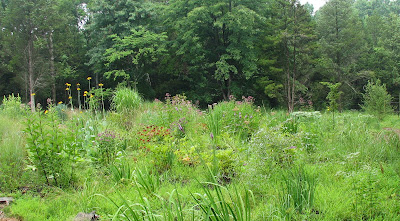The "front" of our house on Federal Twist - the facade facing the road - is actually the back. It presents a simple wall to visitors. The real front of the house is at the back, where an unbroken wall of floor to ceiling windows gives onto the main garden, and surrounding it, the woods.

The choice of where the front garden would be was predetermined by a barren gravel circle at the front entrance. The house is about 165 feet from the road, with open woods in between, so screening wasn't absolutely necessary, but added privacy was desirable since none of the windows are covered. Even more important, I wanted to create a focal point and add visual interest. The photo above is the front garden, still in progress, this past summer. The second photo shows the original front "garden" when we purchased the house in fall of 2004.
The house is a simple, shed-like structure, at least viewed from the side facing the road.

The only notable front views out are from the kitchen window and sliding doors in the dining room. The original view out was onto a circular graveled area about 28 feet in diameter, with a mostly dead crab apple, a couple of scraggly burning bushes (
Euonymous alatus), a line of arborvitae, and two
Sedum spectabile 'Autumn Joy' eaten to the ground by deer. To the side were two rotting, frequently amputated Japanese cherries.
Looking out toward the road, the view of the woods was not without interest but also not particularly notable. We needed something to look at from inside the house, to provide additional screening in place of window and door coverings, and to make the facade facing the road more welcoming - something that would screen our uncovered expanses of glass, providing privacy, while signaling a greeting to visitors and giving clear direction to the house entry, which was hidden at the far end of a dark porch.
After we cleared most of the area, the first plant to go in was a large Ravenna grass (
Saccharum ravennae), which I split in two - a discard of our friend Roberta, who found it overwhelming in her small Lambertville garden (I had put it there). This was in May of 2005. You'll have to click on the photo to see the two grasses in the wide expanse of gravel.

In the top photo you can see how, once the grass matured, its fountain-like shape and large size made it a welcoming gesture to anyone turning into the drive.
Planting continued through that summer of 2005, and by August was essentially finished. I used several
Miscanthus (
Gracillimus, Yaku Jima, Adagio), Joe Pye Weed (
Eupatorium maculatum 'Gateway'),
Persicaria amplexicaulis 'Firetail', catmint (
Nepeta m. 'Walkers Low'),
Sedum 'Matrona', Bluestocking monarda (
Monarda d. 'Blaustrumpf'), a small lilac (personal request from Phil),
Pennisetum a. 'Moudry', a few Japanese Blood Grasses (
Imperator cylindrica rubrum),
Aster laterifolius 'Lady in Black',
 Lychnis coronaria
Lychnis coronaria, purple smoke bush (
Cotinus coggygria 'Royal Purple'), and an inkberry holly (
Ilex glabra) to anchor one corner. I scattered seed of
Verbena bonariensis and bronze fennel, and I kept two of the arborvitae, the legacy Sedum 'Autumn Joy', and self-seeded
Eupatorium rugosum (a really invasive thug I'm now trying to eliminate). The first year planting looks scraggly but by the next spring it had filled out well, as you can see in the next three photos taken in late June 2006.

In 11 months, the
Miscanthus, Joe Pye Weed, and
Saccarum had grown into substantial islands of graceful foliage and the
Nepeta 'Walkers Low', just passing its early prolific bloom, had relaxed into the contours of its surroundings like an old hand.
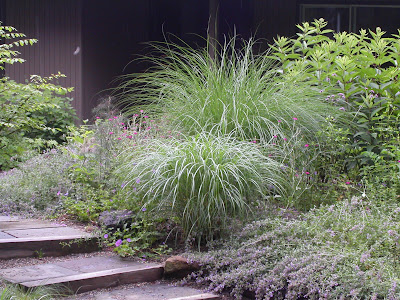
All of this was working on the large scale, creating a new space and transforming the house on Federal Twist into a place with a little more mystery than before.

On the smaller scale, details of flower and foliage shape and texture began to add interest - monarda busy with bees and butterflies ...
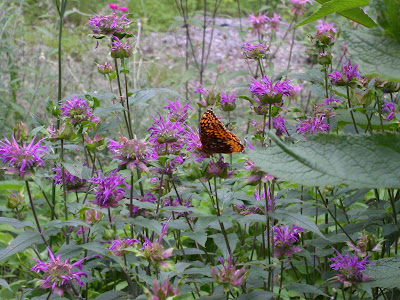
Purple smoke bush graced by the magenta of
Lychnis coronaria ...

and the smoke bush again, with cat mint and
Sedum 'Matrona' against a hedge of burning bush.

Under the gravel is clay, same as everywhere else at Federal Twist. Unlike the main garden at the back, this one is raised above the surrounding grade, so drainage is much better. Though it makes a very heavy planting medium, the clay is rich and, after only two years, it looks like some of the grasses will need to be divided next year.
To finish, a couple of views from this past summer ...
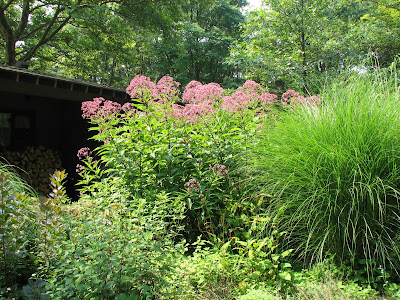
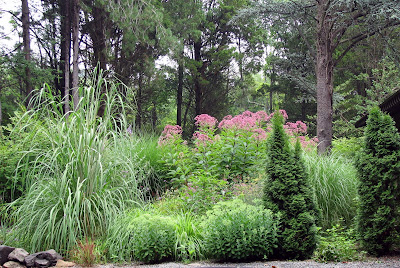
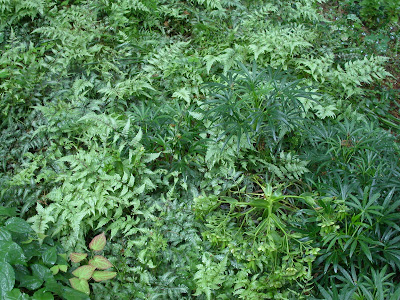
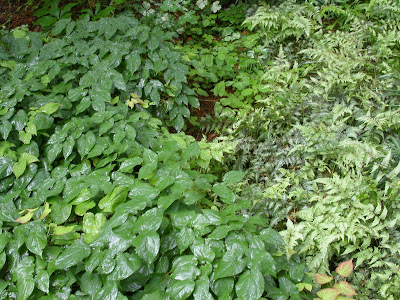


 Already late November and autumn still shows in seed, stalk, tussock, falling leaf... brown, gold, russet, almost black.
Already late November and autumn still shows in seed, stalk, tussock, falling leaf... brown, gold, russet, almost black.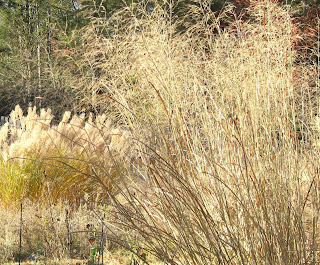
 Then with a tilting earth, a higher sun, warmth will return to bring back green larger and more numerous.
Then with a tilting earth, a higher sun, warmth will return to bring back green larger and more numerous. The only notable front views out are from the kitchen window and sliding doors in the dining room. The original view out was onto a circular graveled area about 28 feet in diameter, with a mostly dead crab apple, a couple of scraggly burning bushes (Euonymous alatus), a line of arborvitae, and two Sedum spectabile 'Autumn Joy' eaten to the ground by deer. To the side were two rotting, frequently amputated Japanese cherries.
The only notable front views out are from the kitchen window and sliding doors in the dining room. The original view out was onto a circular graveled area about 28 feet in diameter, with a mostly dead crab apple, a couple of scraggly burning bushes (Euonymous alatus), a line of arborvitae, and two Sedum spectabile 'Autumn Joy' eaten to the ground by deer. To the side were two rotting, frequently amputated Japanese cherries.

